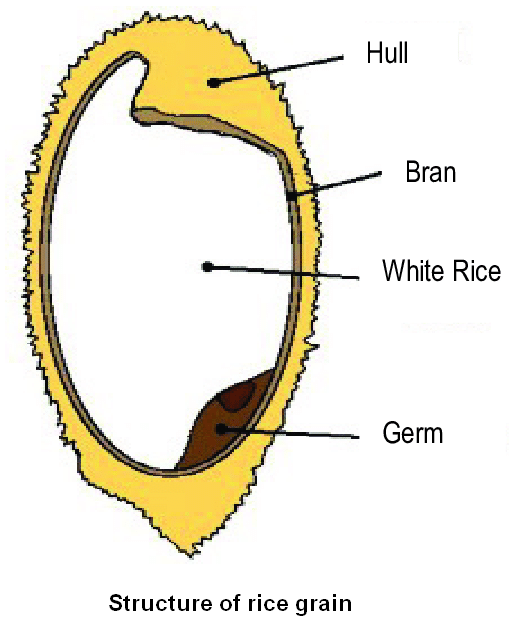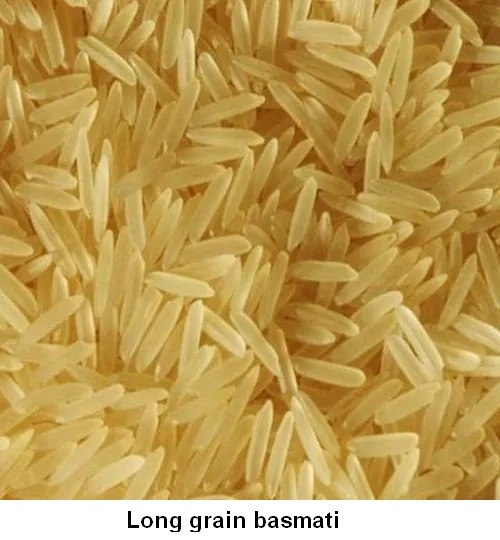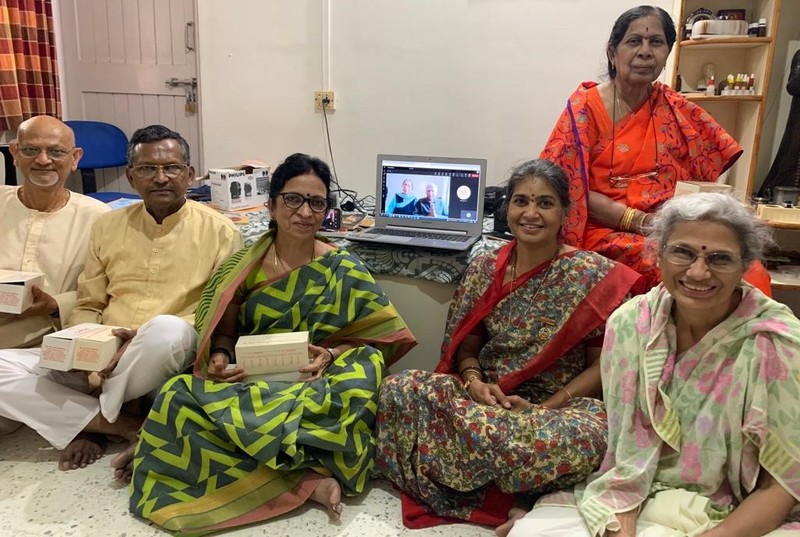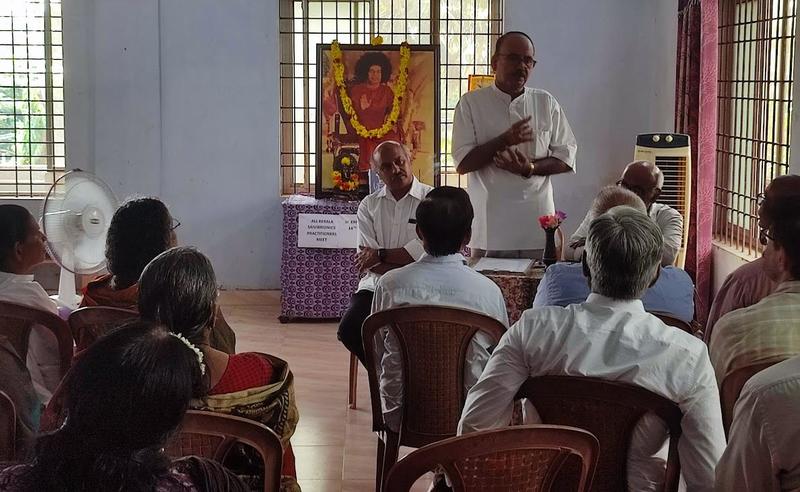In Addition
Vol 14 Issue 4
July / August 2023
1. Health article
Varieties of Rice & its Alternatives for health & joy
“The life principle is like the grain covered in the husk of delusion (maya), same as the rice is enveloped in paddy. The delusion has to be removed; the life principle has to be boiled and made soft and assimilated so that it might add to health and strength. The softened rice can be compared to the Supreme Soul. The mind has to be used for this process. It has to be fixed in truth and the everlasting. To remove the husk of delusion, discrimination is an instrument.” …Sathya Sai Baba1
Prelude
We dealt with how to take care of the three whites in our diet -- milk, sugar, and salt – in the previous newsletters, vol 14 #1 & 2. In this article, we deal with the benefits of various kinds of rice including caution to be exercised regarding white rice. To know the characteristics of various grains in general, whole and not so whole, gluten-free and otherwise, including millets and pseudo-grain like wild rice, refer to vol 12 #5.
1. Rice and its main variants
Rice, seed of a cereal grass, is one of the important dietary carbohydrates with a small amount of protein and fat. It is staple food for more than half of the world’s population, especially in India,  China, and South-East Asia. Available in varied shapes and colours, it can be boiled or steamed and ground into a gluten-free flour. When cooked and cooled, its highly resistant starch helps the colon to stay healthy. A healthy whole grain, it is an excellent source of manganese and some iron and B vitamins, taking different forms due to varied refining processes.2,3
China, and South-East Asia. Available in varied shapes and colours, it can be boiled or steamed and ground into a gluten-free flour. When cooked and cooled, its highly resistant starch helps the colon to stay healthy. A healthy whole grain, it is an excellent source of manganese and some iron and B vitamins, taking different forms due to varied refining processes.2,3
1.1 Paddy rice: Every rice starts its life as paddy rice (unmilled rice kernels in their natural unprocessed state till the hull is removed) considered unfit for human consumption.4
1.2 Parboiled/Converted rice: Paddy rice is soaked in warm water, steamed, and dried in its husk before milling. This parboiled rice is more nutritive than white rice. A study showed when people with type-2 diabetes ate 185 grams of cooked parboiled rice after fasting overnight, their increase in blood sugar was 35% less than when they ate the same amount of regular white rice.5
1.3 Brown rice: We get this rice when the inedible husk is removed from paddy rice while retaining its protective bran layer which contains higher levels of bioactive compounds called phenolics and flavonoids. These are antioxidants, anti-viral, anti-inflammatory, and anti-allergic. Brown rice can ward off every day toxins from the body and prevent cancer and cardiovascular  diseases. It can lower blood glucose and fasting insulin levels, reduce cravings, and aid in weight management. Brown rice may or may not be parboiled and it takes a little longer than its white couterpart to cook as well as to digest, but is more nutritive and retains its natural nutty flavour and is very satiating. When the rice is rolled and the bran is pearled off, it leaves a white kernel intact resulting in white rice.2,3,6
diseases. It can lower blood glucose and fasting insulin levels, reduce cravings, and aid in weight management. Brown rice may or may not be parboiled and it takes a little longer than its white couterpart to cook as well as to digest, but is more nutritive and retains its natural nutty flavour and is very satiating. When the rice is rolled and the bran is pearled off, it leaves a white kernel intact resulting in white rice.2,3,6
1.4 White rice is polished and does not have the fibre rich outer bran and the nutrient-rich germ, but has a long shelf life. Easy to cook and digest, it is starchy, has a soft texture and bland neutral flavour. Athletes normally opt for white rice to refuel after exercise; also preferred during heartburn, nausea, or flare-ups associated with diverticulitis (a gastrointestinal disease) or Crohn’s disease. White rice is not considered ideal for those with diabetes as it might spike sugar levels due to its high glycaemic index (GI)!2,3,6
2. Glycaemic index (GI) and glycaemic load (GL) of rice
2.1 What is GI: Carbohydrates (carbs) have the ability to increase the level of glucose in the blood. GI is a rating system for foods containing carbs to know how quickly it raises the blood sugar level  when consumed. The GI scale runs from 0 to 100. Foods with a GI score 0 to 55 are low glycaemic, 56 to 69 are moderate, and 70 to 100 are high. GI of rice varies from low to high. Aromatic long-grain basmati and brown rice have a lower GI, other varieties have a moderate GI; most of the white rice varieties have GI of 64 to 89 as their dietary fibre gets removed when milled. Arborio rice, starchy white like little pearls, chewy and creamy, gentle on the digestive system, and used in Italian dishes, has GI of 69, whereas Jasmine rice, an aromatic long grain white rice from Thailand, is in a higher GI range (68-80). The more processed the grains are, greater is the effect on blood sugar. GI of white rice can however be reduced to around 53 by cooling it after cooking as it forms resistant starch similar to soluble fibre. Cooking with healthy fats like ghee or oil, or adding vinegar or lemon juice to the cooking water, will lower the GI further. It is important to note that not all foods with low GI are healthy and vice versa.3,7-12
when consumed. The GI scale runs from 0 to 100. Foods with a GI score 0 to 55 are low glycaemic, 56 to 69 are moderate, and 70 to 100 are high. GI of rice varies from low to high. Aromatic long-grain basmati and brown rice have a lower GI, other varieties have a moderate GI; most of the white rice varieties have GI of 64 to 89 as their dietary fibre gets removed when milled. Arborio rice, starchy white like little pearls, chewy and creamy, gentle on the digestive system, and used in Italian dishes, has GI of 69, whereas Jasmine rice, an aromatic long grain white rice from Thailand, is in a higher GI range (68-80). The more processed the grains are, greater is the effect on blood sugar. GI of white rice can however be reduced to around 53 by cooling it after cooking as it forms resistant starch similar to soluble fibre. Cooking with healthy fats like ghee or oil, or adding vinegar or lemon juice to the cooking water, will lower the GI further. It is important to note that not all foods with low GI are healthy and vice versa.3,7-12
2.2 What is GL: To understand a food’s complete effect on blood sugar, we need to know not only how quickly it makes glucose enter the blood stream (GI), but also how much glucose per serving it can deliver. Another measure called GL indicates both the aspects to give a more accurate picture of a food’s real-life impact on blood sugar. GL = GI x amount of carbs per serving divided by 100. Watermelon, for example, has a high glycaemic index (80), but a serving of watermelon has so little carbs that its glycaemic load is only 5. GL ranges from 0-100. Low GL is 0-10, 11-19 is moderate, and 20+ is high. Low GL diet can help with weight loss and reduce the risk of developing type-2 diabetes. According to American Diabetes Association, total amount of carbs in food rather than its GI or GL is a stronger predictor of what will happen to blood sugar; too much focussing on GI or GL may complicate our choices of food.7-12
- Unique varieties of rice
Though the most consumed is white rice, many other varieties with different colours, richer in nutrients, are gradually becoming popular.
3.1 Black rice, often overlooked as forbidden rice, is known as the number one nutritional rock star in rice varieties. A medium grain rice that originated in China, it is naturally gluten-free, rich in  protein, iron, d antioxidants, it can improve eye health and reduce the risk of fatty liver. It has a chewy structure ideal for porridge, pudding, and rice cakes, becomes purple when cooked, and tastes like brown rice.13-14
protein, iron, d antioxidants, it can improve eye health and reduce the risk of fatty liver. It has a chewy structure ideal for porridge, pudding, and rice cakes, becomes purple when cooked, and tastes like brown rice.13-14
3.2 Red rice is the most nutritious with high fibre content, a shade better than brown rice, it can delay premature aging and increase lung capacity. Rice from different regions has its own unique flavour eg, Kashmiri, Himalayan, Thai, and Bhutanese, Matta and other parboiled varieties of Kerala, the strength-giving Mapillai-Samba of Tamil Nadu, red & white Rajamudi of Karnataka, aromatic Gobinda bhog of West Bengal, Camargue of South France, Ulikan of Philippines, and Oryza of African region. Red rice takes longer to cook; it can lead to serious digestive issues if undercooked.15-17
3.3 Rice with medicinal uses: Each traditional rice has medicinal property, is fragrant, delicious, and filling. Illupaipoo-Samba rice of Tamil Nadu, both brown and white, is used to tackle problems like swelling, joint pain, paralysis, and immunity deficiency; Poongar rice is used to reduce gynaecological issues and joint pains in women. Rakthashali, very expensive ancient rice of Kerala, acclaimed from vedic times is an antioxidant, purifies blood, and maintains equilibrium in the body, treats allergies and skin ailments, liver, kidney, and nerve disorders, gastrointestinal, and uterus related problems.15-19
- Caution on Arsenic content in rice
4.1 Arsenic is a natural component in the environment, highly toxic in its inorganic form and a confirmed carcinogen. Arsenic in ground water and soil, especially due to extensive use of pesticides and poultry fertilizer, and consequent contamination of grains and foods is widespread in many countries. Safe arsenic level for drinking water laid down by WHO is 10 µg/L. All plants will absorb some arsenic but rice absorbs more primarily because it is grown in flooded conditions; brown rice carries 80% more arsenic than white as it tends to accumulate in the bran; organic farming does not mean less arsenic. Brown and white Basmati from California, India, and Pakistan and sushi rice from US are considered to contain the least arsenic. Very rarely a rice brand is transparent about its arsenic content and how to address it. In comparison, grains like Amaranth, buckwheat, and millets have negligible arsenic.2,20-22
4.2 Immediate symptoms of acute arsenic poisoning are vomiting, abdominal pain, and diarrhoea, with drowsiness and confusion, followed by numbness and tingling of extremities, muscle cramping (death in extreme cases). High level exposure for a prolonged period may lead to heart disease, cancer, and pigmentation changes in skin, skin lesions and hard patches on the palms and soles of the feet, dementia, and neurological problems.20-22
5. Tips for healthy eating of rice and its alternatives
5.1 Steps to minimise arsenic content: Thoroughly clean the rice with water, soak for 12 to 24 hours, drain and wash again. Cook with a large volume of water using a ratio of 6 to 10 cups water to one cup rice, and drain the excess water afterward. This is a traditional Asian way of cooking by which 30 to 60% of the inorganic arsenic content can get reduced, depending upon the kind of rice. Brown rice should be soaked for a few more hours to wash off the arsenic that accumulates in the bran and get rid of the antinutrient phytic acid which resists absorption of iron and zinc from food. Rinsing does remove 50 to 70% of the valuable nutrients. In one cooking method, a filter coffee maker was used to pass the hot water through the rice as it cooked, this reduced arsenic by 85%; most nutrients were retained but 50% potassium was lost.2,21,22
Best method to reduce arsenic: Parboiling the rice and letting it absorb the water was found to be the most effective, safe, and time saving method to reduce arsenic at home. Pre-boil 4-5 cups of water for one cup of rice, add rice and boil for 5 minutes, discard the water with arsenic, add 2-3 cups of fresh water, bring it to a boil once again and cook the rice in low to medium heat with a lid or until all the water is gone. This method could remove 50% of arsenic from brown rice and 74% from white rice while still preserving the nutrients. It is better to be safe through these methods; lost nutrients can be supplemented in many ways.21
5.2 Use cooked rice correctly to prevent food poisoning: Uncooked rice can contain spores of bacillus cereus bacteria which can survive even after cooking. So, eat rice as soon as it has been cooked. If not possible, cool it within an hour, refrigerate and when ready to consume (within a day), reheat thoroughly. If left for longer at room temperature, the spores can grow into bacteria which will multiply and produce toxins that can cause diarrhoea or vomiting. Do not reheat rice more than once. Cooked black rice should be kept in an airtight container in the fridge; it will stay fresh for 3 to 5 days.13,23
5.3 Enhance the benefit of rice: Eat in moderation as part of a varied and balanced diet mixed with legumes and vegetables. About 270 gm of cereal per day (with max 100 gm millets) is recommended by National Institute of Nutrition, India. When body needs carbs for performance and recovery, it is the best time to consume rice. If one couches after a giant bowl of rice, it will get converted into fat. Greater the variety of rice one eats, the lesser the chance to get micronutrient deficiency.2,16,24-26
5.4 Consider alternatives to rice to sustain the environment, livelihood, and health in the context of depleting natural resources! 2023 is the international year of millets. It is being encouraged for it is both environment and farmer-friendly. It requires minimal inputs, much less water than rice and wheat, is resilient to climatic changes, grows even in poor soil and depleting natural resources, is resistant to diseases and pests, and can sustain the food supply chain. Most millets have higher fibre and protein and lower GI compared to rice and least arsenic, making it consumer friendly.27,28
5.5 Keep the choices simple and eat with awareness. What is important for your overall health is reaching and staying at a healthy weight. If possible, rotate varieties of rice with other available grains like millets (refer vol 12 #5). Include fresh seasonal fruits, vegetables, and good fat in diet. Try a different combination of foods at regular intervals, watch the difference, and stay with what suits you best in terms of health and the joy of eating. Keep exploring and eat joyfully!
References and Links
- Divine Discourse on Tolerance, Sathya Sai Speaks, Volume 1 (sssbpt.info)
- Benefits of rice: Top 5 health benefits of rice | BBC Good Food
- Colon health & Pearling: White Rice Calories, Nutrition Facts, and Benefits (verywellfit.com)
- What is Paddy Rice? (with pictures) (delightedcooking.com)
- Parboiled/Converted rice: Parboiled (Converted) Rice: Nutrition, Benefits, and Downsides (healthline.com)
- Brown Vs. White Rice — Which Is Better for Your Health? (healthline.com)
- The Glycemic Index of Rice – NatureWord
- What is the glycaemic index (GI)? - NHS (www.nhs.uk)
- Arborio Rice Glycemic Index - Rice Array
- The lowdown on glycemic index and glycemic load - Harvard Health
- Rice: Glycemic Index and Glycemic Load. Complete Overview ✅ (glycemic-index.net)
- Glycaemic Index Food Fact Sheet | British Dietetic Association (BDA)
- Black rice is nutrition rock star: Is Rice Healthy? The 3 Healthiest Types of Rice (realsimple.com)
- 11 Surprising Benefits and Uses of Black Rice (healthline.com)
- Red rice: Red Rice: Types, Nutritional Content, Health Benefits, Recipes And Side Effects (netmeds.com)
- Traditional Rice Varieties of India (esamskriti.com)
- Red Rice Benefits: A Complete Guide To Nutrition, Recipes And More - NDTV Food
- Medicine Rice - Illuppai Poo Samba, Raw, Milled Rice (organicwayfarm.in)
- Rakhtashali rice: This Kerala farmer rises to occasion with ‘Rakthashali’ farming- The New Indian Express
- Arsenic in rice! Arsenic (who.int)
- https://foodrevolution.org/blog/arsenic-in-rice/#
- https://www.consumerreports.org/cro/magazine/2015/01/how-much-arsenic-is-in-your-rice/index.htm#
- Can reheating rice cause food poisoning? - NHS (www.nhs.uk)
- Moderate eating is how much? https://www.healthifyme.com/blog/millets/#
- How Much Is One Serving? | Smokefree
- Best time to eat rice: The Difference Between White, Brown And Red Rice | HuffPost Latest News
- Millets are environment friendly: https://unric.org/en/millets-good-for-people-the-environment-and-farmers/#
- Are millets better than rice?: https://tcrconnectingagriculture.com/2020/12/millets-for-diabetes
2. SVP workshop at Puttaparthi 2 to 4 May 2023
After a stringent process of admission, four VPs (three from India and one from USA) got selected. Following a six-week E-course they attended this three-day face to face workshop to qualify as SVPs and took their oath. They enthusiastically learnt the operation of the machine to make specific remedies, process of potentising including making nosodes, effect and modality of broadcasting, and significance of miasms. They were thrilled beyond measure to know how the first prototype was made and then blessed by Swami in a most dramatic manner to render it a divine machine. They felt truly blessed to be the recipient of this unique SRHVP. They expressed that it is a great privilege to become a vibrionics practitioner and now becoming an SVP gives them greater insights into the workings of vibrionics and will help them to serve their patients even better.
Dr Aggarwal in his valedictory address inspired them through tips on how to find apt cards and utilise the machine effectively for treating patients, interspersed with some of his own outstanding experiences. So keen were the four SVPs to acquire even greater knowledge that they proposed regular interactive meetings with the teachers, the first one is scheduled for July 2023.

3. Seminars
1. Kerala Practitioners Meet 14 May 2023
20 practitioners attended this meeting presided over by the District president of Sri Sathya Sai Seva organisation. The meeting started with a homage to our recently departed senior practitioner Rajesh Raman who had played a pivotal role in the growth of vibrionics, especially in Kerala. The Kerala Vibrionics Coordinator 02090, due to his inability to attend physically, addressed the gathering by phone. He inspired them to continue with vibrionics seva with greater vigour. There was a great need to launch Malayalam version of all vibrionics books to overcome linguistic barrier, so that more practitioners may take up this seva. Practitioner 11231 highlighted the need for an effective organisational set up in Kerala and it is heartening to note that ten practitioners came forward to take up various organisational roles. The meeting ended with the charging of 108CC boxes followed by Shanthi mantra.


2. UK West London Seminar 21 May 2023
UK practitioners have been conducting regular refresher seminars at four monthly intervals. This seminar attended by practitioners was hosted by West London group. A number of successful cases of healing were presented to the delight of all as were some interesting anecdotes. Three practitioners made presentations, circulated in advance to all, on specific topics:
Practitioner 00534, a qualified pharmacist spoke on the use of Bach Flower remedies. She emphasized the need to treat the cause, not the disease. Negative emotional toxins bring about chemical and electrical imbalance in the system, showing up as depression, behavioural problems, memory failure, phobias, and learning difficulties. Each illness has several root emotions, so the practitioner should identify the primary mental conflict in the person, give him the appropriate Bach Flower remedy as also all the hope and encouragement to make the patient feel more positive in his journey to health.
This was followed by discussion on how to treat plants with Bach Flower remedies and Plant tonic along with an example on how the plants revived and became healthy.
Practitioner 03598, a recently retired GP, gave useful information on back pain. She emphasized that current lifestyle, especially stress, is not conducive to a healthy ‘back’. Long working hours on computers or mobiles is a big hazard. A weak back is vulnerable to injury like sprains and strains and disc prolapses.
Stress induced hormones can tense up the muscles and make them stiff and painful. Simple walking in healthy and pleasant environment is an antidote to stress and is better than workouts in the gym. Yoga and meditation are good solutions to prevent stress. In a nutshell, healthy lifestyle in the form of regular activity, exercise, fresh air and adequate sleep, and a healthy diet will help keep the back strong. She added that vibrionics along with general counselling by promoting positive thinking can play a part in desensitising the nerves to pain and strengthening the coping mechanism.
She cautioned the practitioners that they should never take ‘back’ pain lightly as there may be other serious but less common causes of back pain - cancer and tumours involving spine or spinal cord or prostate cancer, kidney problems, gall bladder disease and pelvic conditions which can give referred back pain.
Practitioner 00033, a cardiology consultant, presented a PPT on common cardiac conditions and prevention of heart disease, most common being the coronary artery disease caused by build of plaque in the arteries. Common causes are smoking, high cholesterol, obesity, diabetes, high BP, family history and physical inactivity. His advice was to control cholesterol level, especially LDL or “bad” cholesterol, blood pressure, blood sugar by diet control and exercise. He also threw light on the signs of a heart attack - usually chest pain at rest, pain radiating to left arm/both arms/jaw/shoulder/back, shortness of breath, sweating, nausea or vomiting. Damage from this can lead to heart failure.
Practitioner 02802 added, especially in the context of Asian patients, that changing from refined oil for cooking to a healthier option can make a big difference to heart health – refer to our Health article in vol 12 #1.
Full details in power point format are available on request from [email protected]
4. Anecdote: Broadcasting without SRHVP!
In August 2022, while having a bath, the practitioner 10375 inadvertently put the dorsal side of her left thumb under piping hot water falling from the geyser tap. The skin instantly turned dark red with excruciating burning sensation and pain. She immediately got the thought to send CC10.1 Emergencies mentally which she did while praying to Swami intensely; after a few seconds, changing the combo to CC10.1 Emergencies + CC21.4 Stings & Bites, she broadcast the vibrations mentally to the affected area. Lo & behold! Redness on the thumb vanished instantly, restoring the original skin colour; the burning sensation and pain disappeared too. She was in bliss for a very long time!
Note: Don’t depend on this method of broadcasting as it does not always work!
5. In Memoriam
- With heavy heart, we announce that our 83-year-old associate, Dr Ram Gopal Katyal 02806…Malaysia transcended his physical form this year on 24 April, Swami's Mahasamadhi day! As an ardent devotee of Sai Baba, he derived great joy serving in innumerable medical camps in Malaysia and at Puttaparthi over the last five decades. After retiring as a doctor, he learned vibrionics in 2011 because he firmly believed in its healing power and dedicated his time and energy to helping people with this healing system. He served his last vibrionics patient on the day before he was admitted to the hospital just two weeks prior to leaving his physical form! His commitment to service was unwavering. He touched the lives of many people and will be dearly missed, leaving us with a sterling legacy of inspiring service and devotion. He was a shining example of the principle that the hands that help are holier than the lips that pray. May we follow in his radiant, dedicated, and loving footsteps.
- We are sad to announce the loss of our 84-year-old practitioner from Nagpur, Dr Rewati Raman Chourasia12054. On 7 May 2023, he suffered a massive heart attack, just six days ahead of his 85th birthday. He became AVP in 2010 and qualified as VP in 2017. Sincere and diligent, for many years he offered regular vibrionics seva in a temple in Vikas Nagar, Nagpur. During his final years he was unable to move out of his home where he looked after his bedridden wife. May his good soul merge in Swami's infinite Love!
